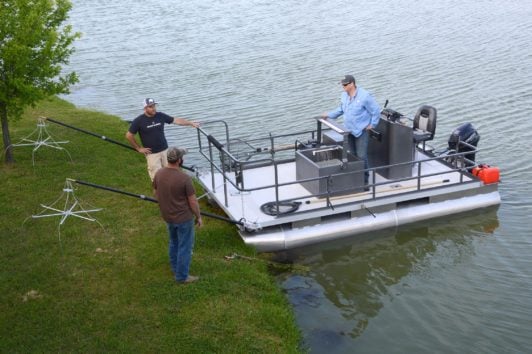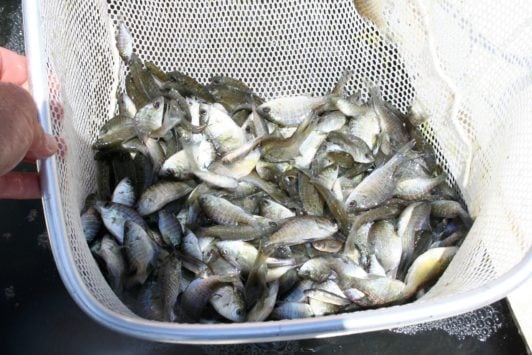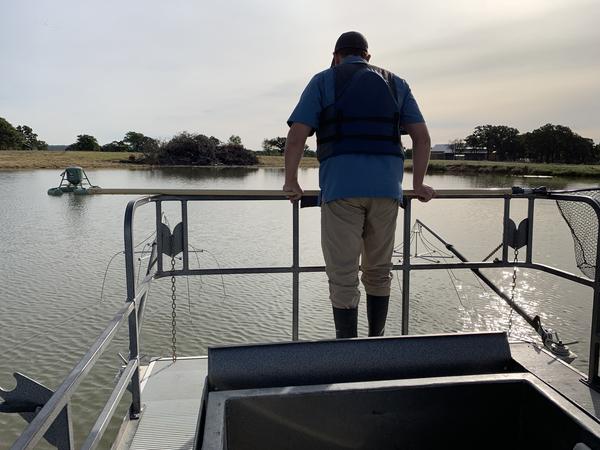Simply put, electrofishing is the process of generating and distributing a controlled electrical field into the water for the purpose of sampling fish. Typically, and in most small lake and pond environments, electrofishing operations are conducted from a dedicated electrofishing boat.
The boat and associated equipment are designed to both produce and distribute the electrical field while safely protecting the operators from electrical current. The following article will discuss the fundamental premise behind electrofishing and how you (the lake or pond owner) can use the data that is produced advantageously for fisheries management.
Basic premise of electrofishing
Most electrofishing boats will have a way to generate controlled power, usually from an air-cooled, gas powered generator. In the southern portion of North America, most fisheries professionals choose to operate with pulsed, direct current, rather than alternating current. The latter is generally considered to be more hazardous and is not widely used. The power created by the generator is sent to a pulsator, or control box, that changes waveform and other characteristics before it is sent out to the probes.
Typically, most electrofishing boats have two booms that extend out past the bow on either side of the boat. At the end of each boom is a metal array that dangles in the water, called probes, which act as the anode (-). Usually, the hull of the boat acts as the cathode (+). An electric field is created between the probes and the hull of the boat once the operator decides to shock. The boat is safe to occupy while shocking because it is also grounded to the water.

The range and extent of the electrical field is controlled by the operator of the electrofishing boat, and is dependent upon water quality characteristics such as specific conductivity and temperature. Under ideal conditions, the effective electrical field is roughly centered close to each probe and extends 10 feet or so to each side of the boat and approximately 6 feet or so beneath the probes. This is the swath, or area that is actively sampled for fish. Once fish encounter this field, a physical response to the electrical field, called galvanotaxis, is elicited. Galvanotaxis is the orientation to an electric field. This means that fish will actively turn toward, or orient themselves, to the electric field.
The pulsed nature of the direct current causes the fish to swim toward the most intense portion of the field. This results in fish that are drawn towards the probes. This is why many operators choose to shock cover and slowly the pull the probes away, drawing fish from submerged structure like brush piles and reeds. It is the responsibility of the dip netter, usually positioned at the bow of the boat near the probes, to capture fish once they are within range. The fish that are collected are placed within an insulated live well and held temporarily until a single round of electrofishing operation is completed.
What happens after fish are collected?
Fisheries biologists record the length and weight of the fish, and make observations on physical condition. Typically, fish recover from the field within minutes after exposure. The field is just used to stun and disorient the fish to make collection easier. Efficient operators, like Pond King fisheries biologists, know just how much current to apply to effectively sample without harming the fish. The data retrieved by electrofishing is then used to assess population metrics like density, abundance, community composition, and condition specific factors. Pond King Biologists summarize this information within a report that is given to the principal client who requested the electrofishing service.

Electrofishing surveys are by no means depletion-based surveys, meaning biologists do not shock every fish in the pond. Instead, they sub-sample the overall population. An analogous example would be taking a handful of jelly beans from a large jar full of jelly beans and assessing the color, quantity, and types of jelly beans from that sample—and then using that information to make an knowledgeable decision about the overall contents of the jar. Fisheries biologists do not see all of the jelly beans, or fish, but do see enough to make well informed estimations based on the sub sample of the overall population.
The trick to this process is that fisheries biologists do everything they can to ensure that the sub-sample is reflective of the overall population. One way to ensure this is to take a large enough sub-sample, which is dependent on system size. The report generated from this data is a way to gauge management decisions that will influence the entire population, for specific goals.
Value to fisheries from a management perspective
Electrofishing survey reports provide valuable fisheries insight into both the way a population is structured as well as the condition of individuals within the population. For Bass fisheries, this entails obtaining a concise snapshot of both the prey (forage) and predator population. Pond King biologists assess the length distribution of all sub-sampled Bluegill and other prey species. Understanding how the forage population is distributed by length provides insight into the amount of competition (between Bass) and predation (by Bass) that occurs.
Both length frequency and condition specific factors are evaluated for Bass and are assessed by comparing relative weight among size groups and across the subsample obtained from electrofishing surveys.

Once assessed, Pond King biologists summarize the observations, data, and any trends that may be important to fishery or fisheries surveyed. The report contains graphs of population trends and explanations of any deficits that may have been found. Included in each report is an executive summary and associated recommendations for fisheries improvement. A detailed cost analysis and seasonal management schedule are specified for management consideration. Of course, Pond King biologists don’t just stop there.
For your convenience, a Pond King Biologist is always on staff during business hours to discuss your system in detail and answer any and all questions you have concerning your fishery. The goal of any good report (and biologist) is to maximize fisheries improvement while evaluating cost and effort. At Pond King, we don’t recommend a strategy, product, or stocking unless it will make a noticeable difference in your fishery.
After all, the same goal is shared: growing trophy Bass as quickly and as efficiently as possible. A Pond King electrofishing survey is the ideal way to make sure that you reach that goal.




